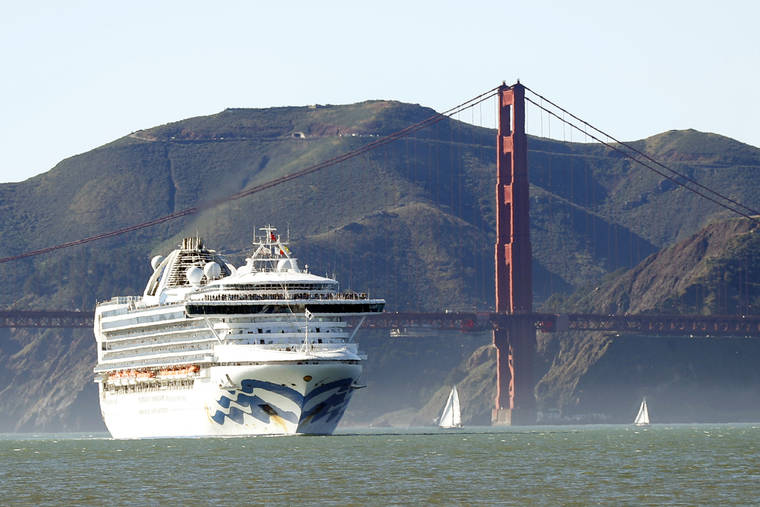State health officials said Wednesday they are monitoring a situation regarding a cruise ship that recently made stops in Hawaii and might have had passengers previously exposed to COVID-19, the recently identified coronavirus that has infected nearly 100,000 people worldwide since it was discovered in late December.
During a news conference Wednesday, Gov. David Ige said the state was informed that two passengers on a cruise aboard the Grand Princess — which sailed from San Francisco to Mexico Feb. 11-21, but not to Hawaii — tested positive for COVID-19. One of those individuals has since died.
However, the ship — which embarked on a new cruise to Hawaii Feb. 26-29 and is now en route to San Francisco — visited four ports on four different islands, he said.
“A crew member became ill and was admitted to Hilo Medical Center,” Ige said. “We were able to test that individual and he or she is negative for COVID-19. As of right now, we’re told one person on board the ship is quarantined. We are also told that there (have) been confirmed cases of influenza. So we do want to remind everyone that we are in influenza season. There are a number of cases of influenza here in the state of Hawaii, as well as across the country, and many of the symptoms of influenza are the same as COVID-19.”
State epidemiologist Sarah Park said that 54 passengers on the first cruise continued onto the current cruise, but other than the crew member, no other illness was reported while in Hawaii.
The crew member was one of three individuals in Hawaii who tested negative for the disease on Tuesday, state Health Director Bruce Anderson said.
According to Anderson, the state is working with the U.S. Centers for Disease Control and Prevention to monitor the situation.
“The CDC has not identified any specific risks for Hawaii, and we will continue to work with them to determine if there is a potential threat, but again, at this time, there’s no threat to anyone in Hawaii,” he said.
Park said if and when a specific risk to Hawaii is identified, the DOH would start its investigation, which would entail looking at potential close contacts and itineraries of those individuals.
“At this time, the CDC has not indicated there’s any action for us to do as far as we’re aware,” she said. “So we continue to monitor the situation.”
As of Wednesday afternoon, six individuals in Hawaii who were under investigation had tested negative for the virus, while 72 were self-monitoring under the supervision of the DOH, including three on the Big Island.
No COVID-19 cases have been confirmed in Hawaii.
On Wednesday, Ige also issued an emergency proclamation that would authorize the use of state funds, as appropriated, for the purchase of supplies and equipment and the speedy response to conditions that may be created by COVID-19.
The proclamation also gives the state funding flexibility and allows the governor to suspend laws that may impede the efficient execution of emergency functions, the administration said in a news release.
The disaster emergency relief continues through April 29.
Ige also appointed Lt. Gov. Josh Green, a Big Island physician, as the administration’s liaison between the state and health care community as it pertains to COVID-19 preparedness and response.
Green will evaluate the medical community’s readiness to deliver care to those who might test positive for the virus and evaluate the current equipment supplies, coordinate efforts to secure additional equipment, and advocate for funding at state and federal levels in cooperation with the governor and Hawaii’s congressional delegation.
“As we continue to ramp up our statewide efforts to address the growing COVID-19 threat, we are doing everything in our power to prepare for any possible cases and the resulting impact on our health care system,” Ige said in a news release. “Because Lt. Gov. Green is a physician, he is uniquely positioned to act as our liaison with health care officials across the state.”
Congressional leaders on Wednesday also approved $8.3 billion in emergency funding to respond to the outbreak, including $4.5 million for Hawaii.
The bipartisan deal also include telehealth legislation authored by Hawaii U.S. Sen. Brian Schatz, which will expand the use of telehealth services during the current outbreak.
According to a news release from Schatz’s office, the deal will include $1 billion directly to state and local governments to conduct preparedness and response activities; $3 billion for research and development of vaccines, other treatments and tests; $500 million for pharmaceuticals, masks, protective equipment and other medical supplies; and $100 million to fund community health centers.
“While there are still no confirmed cases of the coronavirus in Hawaii, this federal money will help fund our state’s response efforts and give us additional resources to keep people safe,” Schatz said.
“The Congress has worked quickly to advance a robust response to this public health emergency,” said Hawaii U.S. Rep. Ed Case, a member of the House Appropriations Committee. “While state and county governments and other entities in Hawaii and throughout our country have been on the front lines to date, this is clearly a national matter which requires the full mobilization and application of national resources across the board.”
U.S. Sen. Mazie Hirono said she, too, will support the package when it is voted on in the Senate, “and will continue to advocate for a swift and aggressive federal response to this public health emergency.”
Email Stephanie Salmons at ssalmons@hawaiitribune-herald.com.






